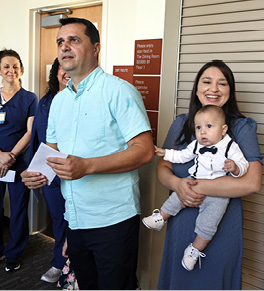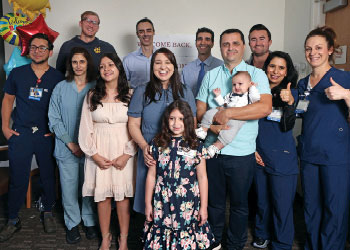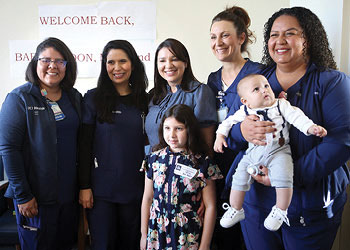Mother, baby saved from deadly birth complication

Nearly six months to the day after her son Landon was born, a grateful Rita Tira returned to UCI Medical Center this week for a reunion with the caregivers who worked heroically to save her from a sudden and deadly complication during childbirth.
An experienced mom of two, Tira, 34, wasn’t worried about her third pregnancy. But in early June 2023, after 22 hours in labor, she developed a rare condition called amniotic fluid embolism (AFE).
AFE occurs when amniotic fluid — which surrounds the fetus in the uterus — enters the mother’s bloodstream and triggers a severe allergic reaction that can lead to cardiovascular collapse. It has a mortality rate of 60% to 80%, with half of mothers dying within the first hour along with a 30% risk of fetal death. AFE accounts for 10% of all U.S. maternal deaths, according to the National Institutes of Health.
Fortunately, UCI Health high-risk pregnancy obstetrician Dr. Jonathan Steller was on duty that day, along with the specialty medical teams that ultimately saved Tira's and Landon’s lives.
Waiting patiently
Tira’s pregnancy had been uneventful, but two weeks before her due date, the community obstetrician who had delivered both her daughters, expressed concern that the fetus was already quite large for her small frame. He wanted to induce labor.
When she and her husband, Fabian, said they preferred to wait a bit longer to see if the baby would arrive naturally, the doctor advised them to have her baby delivered at UCI Medical Center, where a high-risk pregnancy team would be on hand should complications arise.
At one week overdue, the couple decided they had waited long enough and arrived at the medical center’s Douglas Hospital in the early evening of June 4. They were immediately seen by the labor-and-delivery team. After a careful examination, the doctors recommended inducing labor.
Steller and the nursing staff began monitoring mother and baby for what appeared would be a normal labor. But 22 hours later, the fetal monitor began sounding alarms. The baby’s heart rate suddenly plummeted, an indication that he wasn’t getting enough oxygen.
“It went down and stayed down as we tried to figure out what was going on,” recalls Steller. “Babies in the womb only have about a six-minute reserve of oxygen, so time was of the essence.”
Within four minutes of the drop in the baby's heart rate and after standard interventions failed, the obstetrician told the team to roll Tira to an operating room for an emergency Cesarean-section. He ran down the hall to prepare.
A perfect storm
Thus began a perfect storm that would test the unique skills, expertise and teamwork that only an academic medical center is equipped to provide.
Dr. Taizoon Q. Dhoon, who leads obstetric anesthesiology at UCI Health, and Dr. Ramin Rahimian, the anesthesiologist who had given Tira her epidural, had just ended their shift, passing Tira’s care to Dr. Joseph B. Rinehart. But when Dhoon and Rahimian learned what was happening, they returned to help Rinehart and Steller save mother and baby.
Tira was conscious when they wheeled her into the OR. She even helped the team transfer her to the operating table. The anesthesiologists administered pain medication and began to monitor her. Suddenly, she began showing signs of distress. Because the Romanian émigré isn’t fluent in English, they couldn’t tell whether she was in pain or something else was wrong.
In that first minute in the OR, Steller performed a C-section and delivered a healthy baby boy, who was rushed to the neonatal intensive care unit (NICU) to have his oxygen levels regulated and other vital signs monitored.
Steller immediately noticed there was no bleeding at the uterine incision, which isn't normal for an area full of blood vessels that have just been cut. "She's not bleeding," he yelled over the curtain that separated him from the anesthesiologists.
“That told me her heart was not beating, nothing was pumping blood through her system,” he says.
Gathering clues
Tira soon lost consciousness, but her vital signs — blood pressure, oxygenation and heart rate — remained normal. Suddenly, her heart rate plummeted then skyrocketed.
“Our initial thought was that she’d had a seizure,” says Rinehart. “When patients seize, which is a possibility in a high-risk pregnancy, they lose consciousness and can have those big swings in heart rate.”
He called for a bedside ultrasound to check her heart. “We knew something was happening, we just didn’t know what.”
While they were reading the ultrasound, Tira’s blood oxygen and carbon dioxide levels dropped, a sign she wasn’t breathing. Her skin turned a mottled blue, further evidence of oxygen loss.
They rushed to insert an oxygen tube. “A normal carbon dioxide level is 40, and even with the endotracheal tube, we were getting only an eight, indicating complete circulatory failure,” says Rinehart. “At the same time, the ultrasound showed her heart was not moving.”
“We looked at each other like, ‘Oh, my God,’ and immediately started chest compressions because it was obvious that something horrible was happening.”
Her condition continued to deteriorate, which Dhoon says is highly unusual for “someone who was a healthy 34-year-old just a couple of minutes earlier.”
After two rounds of chest compressions administered with the drug epinephrine to boost Tira’s arterial blood pressure, the team jump-started her circulatory system.
The second wave
By then, the team of anesthesiologists, obstetricians and cardiologists, who now numbered more than 20, had ruled out heart failure and decided they were battling an amniotic fluid embolism, a complication of pregnancy that few team members had ever seen.
An AFE first leads to rapid lung and heart failure, followed by cardiac arrest due to a lack of oxygenated blood. Next comes hemorrhaging from the uterus or C-section incision, followed by disseminated intravascular coagulopathy (DIC), which prevents blood from clotting throughout the body and requires a massive blood transfusion.
Another race against the clock ensued. While the anesthesia team attended to Tira’s heart and respiration, Steller and his OB-GYN team worked furiously to stitch up the C-section incisions before hemorrhaging began.
Simultaneously, Dr. Gagan Mathur, medical director of transfusion medicine at UCI Health, arrived to analyze what Tira needed, manage any abnormal blood clotting and help prevent damage to her organs.
Using highly specialized tests, he was able to get a real-time read on the proteins and clotting factors in Tira’s blood. “We can really pinpoint the patient’s exact needs in that moment,” he says.
Because UCI Health has the only on-site hospital blood bank in the region, Mathur was able to quickly begin the transfusion. All told, Tira would need 15 units of red blood cells, 13 units of plasma, three units of platelets and nine units of clotting factor .
Calming the tide
“I don’t say this very often, but I have no doubt in my mind that if Rita had been at any other hospital, she wouldn’t have made it,” says Rinehart.
Rahimian agrees wholeheartedly, “When I left that day to go home, I had exactly the same thought. I was so glad this happened here because we are a Level I trauma center and we have a blood bank.”
Steller notes that everything their team needed was immediately available.“There is a crash cart right there, we have a massive transfusion protocol and we have specialty teams that can react immediately," he says.
“When you have a scary thing like an AFE — that is critical. You only have minutes to intervene and even that might not be enough. But if there is any delay at all — it is over.”
Dhoon, who had seen four previous AFE cases in his medical career, calls Tira’s case “one of the most serious I have ever seen in an obstetric patient. It took over five hours to manage and stabilize her.”
Although Tira doesn't remember anything about her brush with death or much about her nine days in the hospital, she told the assembled doctors and nurses, “I’m so grateful to everyone who cared for me.”
Steller says short-term memory loss is common after a traumatic event. But he adds that she has no residual damage to her heart, lungs, brain or other organs, which can often result from an AFE.
“We got on CPR pretty quickly and that always helps preserve brain function,” says Rinehart. “The communication between all the teams was exceptional — they activated quickly and I believe that is what truly made the difference.”A family’s miracle
Tira’s AFE was striking because the baby sent the first alarm when his heart rate abruptly crashed.
“In a sense, baby Landon helped us save his mom because he forced us to rapidly move to the OR,” Steller says. “That stopped our anesthesiology team from walking out the door at shift-change and mobilized the cavalry before we even knew we needed one.
“We can’t overstate how important this was. Normally, the fetal heart-rate monitor gives baby a voice to yell, ‘Save me!’ In this case, he screamed, ‘Save my mom!’ so that we could save them both.”
Fabian Tira was overcome with emotion hearing the doctors and nurses recount the events of that day.
“This really is a miracle to us,” he says. “God worked through the hands of these people, giving Rita her life back. If we had gone anywhere else, there would not have been the blood bank or all these experienced doctors working together to understand what was happening and help her so quickly.”
Labor-and-delivery nurses Alicia Larios and Adriana Kim marveled at how calm the father seemed that day.
In truth, he says, “I was in shock, like in a fog. It was hard to take it all in. But I do remember afterward asking Dr. Steller what to expect. He said without hesitating, ‘I expect her to make a full recovery!’ and that’s exactly what happened.”
Rita Tira will need a follow-up cardiac exam but she is feeling great, almost back to normal.
“Landon is thriving,” she says, cuddling the boy as his sisters,12-year-old Samantha and 8-year-old Naomi, listen attentively. “I’m happy to be back caring for my kids, cooking for family and friends and volunteering at our church.”
For Dhoon, the reunion was a reminder of why they come to work every day. “It's really rewarding to see how all our teams came together and changed the course, not only for Rita but also for the baby and the whole family.”
Related stories
- UCI Health Maternity Services earns 'high-performing' rating for third consecutive year ›
- Regular blood donor knows the need is great ›
- Mom survives rare ovarian cancer ›
- Crash survivor celebrates his "staying alive" birthday ›






